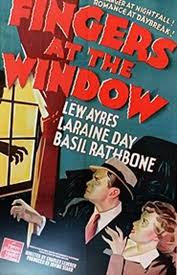
In Chicago, Illinois, the papers have been full of stories about an axe murderer terrorizing the city. Police inspector Gallagher (Charles D. Brown) is stumped. He consults with psychiatrist Dr. Kurt Immelman (Miles Mander) to come up with a theory as to what type of person would be so depraved as to kill five random people. The police know that each murder was committed by a different person. Each of the perpetrators appears to be in a paranoid schizophrenic state. Lost in their own world, the police get nowhere trying to interrogate them. The murders continue, and a sixth person is killed.
Oliver Duffy (Lew Ayres) is an out of work actor. While walking home from his last performance he sees a shadow figure following a young woman. He approaches the woman, whose name is Edwina Brown (Laraine Day) and offers to walk her home. When the ax carrying figure tries to enter her house, Oliver watches outside her fire escape throughout the night to keep her safe.
The next night Oliver lays a trap for the attempted murderer. The man is caught and turned over to the police. The police put Edwina up at a hotel to keep her safe, but a different axe wielding schizophrenic tries again to kill her. Oliver figures out that the murders, although seeming random, are being orchestrated by an unseen villain.
Oliver becomes invested in the health and wellbeing of Edwina. He begins his own investigation of the axe murders. He now believes that someone behind the scenes is manipulating people and hypnotizing them into committing the murders. Oliver believes that someone from Edwina’s past is responsible, but Edwina says he has no idea why. As Oliver investigates, he ends up making himself a target along with Edwina.
“Fingers at the Window” was released in 1942 and was directed by Charles Lederer. It is an American crime mystery and a rom-com.
There are some silly parts, but overall, it ended up being a rather decent, though flawed, “B” mystery. I’ve seen some ads that refer to the film as a Sherlock Holmes mystery. It is not. Basil Rathbone, who played Holmes in several films in the forties, is in the film, but he is a shadowy figure that plays a part in the murders, not a detective solving crimes.
Although the movie was a lot of fun and easy to watch, I did have some concerns about some of the plot line. Part of it involved hypnotizing people into committing murder. Outside of the fact that, according to belief, people under hypnosis would not do something they would not do under normal circumstances, the person doing this hypnosis was never actually a doctor. No explanation is given as to how he learned this medical skill. When the reveal comes, we find out why these seemingly random people are being killed. That epiphany begs the question, isn’t there an easier way to do away with over half a dozen people than by hypnotizing an equal amount of random people into being axe murderers? Suffice it to say, there are many plot holes in the thriller portion of the film.

